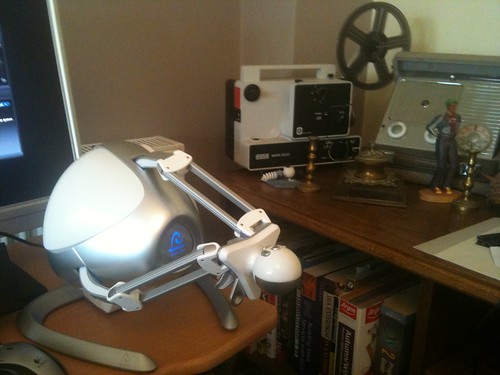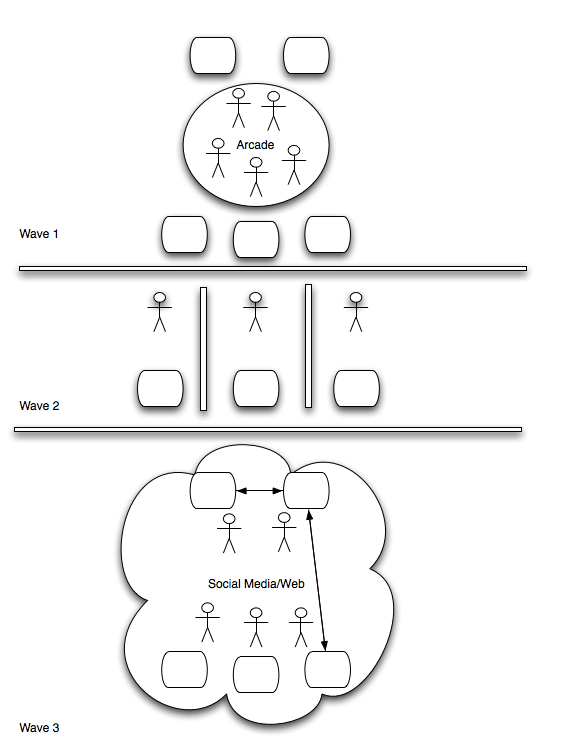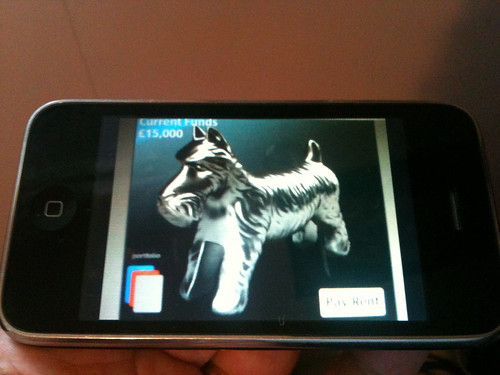After recording the Cool Stuff Collective second episode using the Haptic 3d device it made sense to get one and see what the predlets, and maybe their school, could do with one. Whilst the haptic show does not air until 20th September I thought it was worth sharing some initial impressions of ownership. Basically it awesome !
The entire package is called Chameleon 3d from A1 Technologies. A1 Technologies are the UK distributor of both the Novint Falcon (The haptic device) and the Anarkik3d Cloud 9 modelling package
The Falcon has a self contained set of mini games and tutorial demos. Although windows drivers tend to be a bit of a pain if you follow the right instructions it dos just work first time. The initial demo lets you feel a number of textures and forces rough, smooth, magnetic, rubber, honey etc. It makes for a very impressive feel for the potential.
Whilst I did spark up the haptic patch for Half Life 2 I was more interested in the creative modelling of Cloud 9 for the moment (more on virtual world and game navigation in another post)

Here is the Falcon nestled with some much older tech gadgets.
The Falcon is quite a large device but sits on a nice sturdy base. It needs some weight to be able to offer resistance and not zoom across the desk. The footprint is about the same as the old microsoft sidewinder force feedback sticks I used to have for Combat Flight Sim.
On Cloud9 I dived straight in and in time honoured tradition “it all started with a cube”.
I pushed, prodded and deformed the cube both from the outside and from the inside too.
The video shows the resulting modified cube, then it published to Unity3d as an OBJ file. Finally it shows predlet 1.0 having a go. It really is very intuitive and very compelling to model with. I have a few ideas of things I want to try but like any modelling tool that also needs some inspiration and talent. As the creation can be exported as OBJ (or STL if you want to 3d print them) then can of course be put into other 3d packages to have extra effects applied.
Now when are Second Life going to sort out meshes 😉 I can generate some very organic structures then even as a techie.
If you want to see the actual unity3d spin around it is here I published it from the free windows version as my Mac paid for version is on the version 3 beta and so cant publish to the web yet.
BTW it was using this that predlet 1.0 uttered the immortal words “Dad, I love you job its way cool” 🙂
future
Clever editing and great use of Youtube annotations
People sometimes moan that the user contributed web is full of rubbish, but whilst that may be true it does mean that talent shines out more. I have been enjoying the occasional watch of Mystery Guitar Man’s work on youtube.
It is deceptively difficult to create edits like this. I love the use of annotations at the end too.
Many of us have the equipment and software to create great video and music now. So the fact there is an open and free distribution channel (i.e. the web not just YouTube) is fantastic.
If you want to, and if you have the talent you can just get on with it 🙂
Fiducial Markers and Unity 3d
I was looking around for a quick way to use the wonderful Reactivision camera based marker tracking. Ideally I really wanted a fully working Reactable, but without a projector and the music and light software and the physical elements like a glass table I cant really do what I want to do in the time I need to do it.
I bumped into a project from a few years ago the tangiblaptop that was aimed at using the laptop screen rather than a projector to display the things that happen to the markers that are also placed on that surface but picked up by the camera. It looked good but I thought I needed something with a bit more variety.
Then I saw this Uniducial . A small library and and couple of scripts to drop into Unity3d.
Within seconds I had objects appearing and disappearing based on the markers they could see in the camera view.
(I have done a few things with these before as did Roo back in the day
However I think the unity3d gadget is going to be very useful indeed 🙂
RepRap – Open Source 3d Printing – Changing Society
I realised that whilst I talk about RepRap a lot to people and have blogged elsewhere about it this blog has no good reference to RepRap. So here it is.
In putting a shout out for help and ideas on 3d printing for the cool stuff collective RepRap keeps getting mentioned by people. It is an intriguing project and has the sort of spirit and goals that I really relate too.
RepRap is an opensource hardware and software project to build a 3d printer, one of whose aims is to be able to print and replicate the parts to make another RepRap printer.
RepRap from Adrian Bowyer on Vimeo.
The video above is from Adrian Bowyer the inventor of RepRap, it has some great points about replicating nature with insects and flowers, plus you can see how a printer works.
To people who have not yet Grokked the whole massive impact this micro/local manufacture will have there is something very primeval about explaining the self replication by a piece of hardware, that seems to sit well with us humans.
I am fairly convinced that saying this machine is able to make the parts for itself is one of the most obvious examples of a use case. It is also both a joke, threat and obvious at the same time.
I often talk about the redistribution of manufacturing and the cultural impact it will have, but increasingly I am also talking about the feedback loop that occurs when those things manufactured are placed into our lives and then by their very existence alter the things that occur around us and to us.
Think about how the remote control on the TV altered our homes and the way we used television. It took a few years for everyone to upgrade to a TV with a remote, but they are pretty ubiquitous now. Imagine how quickly an innovation such as that would infect/enhance our homes and lives if we could print them out as they happened.
The spread of the end product in this way would also lead to even quicker open source projects based on whatever this device or object was, projects to take that and use it in even more advanced ways, sharing the information along the way.
This can be a cycle in fashion accelerated not to seasons and production runs but to right now, to changes in architecture, to sudden new character collectible toys and games.
You do not have to ponder this very long to add together the power of sharing across the web and willingness to self organise with an open source mentality combined with not just software or ideas but with physical items and you can see that there is an even greater cultural shift, and its way more than people say hi to one another on Twitter and Facebook.
It really is very exciting and scary at the same time.
The open source approach and mentality is really a giant feedback loop with adjustments and mutations made along the way like a genetic algorithm. Throw atoms, not just virtual digits and the proposition expands a great deal.
Cool Stuff Collective – Something unusual has happened
One way and another something very interesting is brewing here. After an intro from a good friend (thankyou Scotty!) I started to advise a new kids tv show just commissioned by ITV here in the UK. It is being produced by Archie Productions (there is some press release info at the bottom of this). Its called Cool Stuff Collective.
Amongst other things I was tasked with explaining some future thinking tech to go with all the cool toys and gadgets. That has morphed a little from back room advice into a slot on the show.
Yes that’s right it looks like I will be presenting and explaining some of the cool tech and futures that I love so much. We start studio filming in a couple of weeks, and if all goes according to plan and I manage to present this OK I think this will rock.
We had a meeting today at MTV studios in Camden and talked scripts, schedules, kit, extra ideas for the segment and how this might all work. The main presenter Sy Thomas is up at the Edinburgh festival so I may not get to meet him until the day.
So it sounds pretty exciting and I hope I make these little segments as forward thinking as possible and get people enthused. Its not all metaverse either 🙂
ARCHIE PRODUCTIONS WINS CITV COMMISSION FOR ‘THE COOL STUFF COLLECTIVE’
Gadgets, games and all that’s cool for 7-12 year olds
London, 27 July 2010. CITV has commissioned a brand new kids series The Cool Stuff Collective from UK-based independent kids and entertainment specialist, Archie Productions. The studio-based magazine review show aimed at 7-12 year olds will showcase and road test anything that kids might want to own, consume, watch, download or play. A total of 13 x 20-minute programmes are to be produced for the autumn.
The series is presented by Sy Thomas (The Kids Choice Awards, Nickelodeon/MTV; Me:TV, Slime Across the UK, Nickelodeon; Little Howards Big Question, CBBC), a tirelessly enthusiastic and experienced kids’ presenter who also happens to be very funny and a self-confessed geek. Keeping track of all the amazing new gadgets, games, movies, apps, websites and books that kids might want to know about, Sy will front The Cool Stuff Collective from Cool HQ.
Jamila Metran, CITV Programme Manager, says: “We’re extremely pleased to be collaborating with Archie Productions on The Cool Stuff Collective. It’s a format we believe fills a huge editorial gap in the UK for our core audience.”
John A. Marley, Creative Director at Archie Productions, adds: “We’re very excited to be working with CITV on such a great new series which is all about bringing the very latest new stuff to the attention of the people who want it the most…kids! The Cool Stuff Collective reviews the products that kids covet and think about spending their pocket money on, but we’ll do it in the most imaginative ways possible.”
Family gaming – in context options, why not more of them?
I have been considering the PEGI and content ratings of games more than usual recently due a project I am working on. Having to make sure that things are not 12 or over is actually quite a challenge in gaming circles.
Much of this seems to be not just related to violence but to the language used. Games actually offer a great deal more flexibility with clever design to be able to be adjusted to the right age range without losing some of their coolness and anarchy.
A prime example is the excellent Rock fest that is Brutal Legend
Whilst playing the intros it challenges you to make some option decisions about the type of content you would like to experience.
In the scheme of things Brutal Legend is a mission based beat-em-up and RTS but heavily themed with Rock imagery. The main character is played by Jack Black. There is a fair amount of hitting things and casting spells but I have found the predlets have enjoyed watching most of it. In particular they loved Ozzy Osbourne shout rock and roll and throwing the sign of rock. The music is great and whilst they dont actually play it I am happy for them to see its cartoon brilliance on screen whilst I play.
At the start of the game I was asked if I wanted the profanity or the other option of “it sounds funnier when it bleeped out”. With the predlets around that seemed better, and it was funnier.
As you can see below there is also an option to turn off the “gore” which is games terms is not really much more than watching Ben 10 as it is so cartoony yet funny. However the option is there to turn it off

Other media, films, books etc are not able to adjust or be able to be toggled like this.
If a few more things tried this, in particular with dialogue, then I would be able to let my predlets see and play a few more quality games.
This does not stop the fact the content is in there to be unlocked of course so some parental responsibility comes into it, and there is still room for pure 15+ or 18 entertainment, but some of it is so borderline we should be able to choose and turn some features off.
The game changing in games – gamification
I was recently considering what the cycle of evolution has been in the games industry and why it is a struggle for some to see the scope of the change, whilst to others it is obvious.
I drew this picture to illustrate the evolution of not just the technology but of the social aspects of gaming.

It stems from the origins of the games arcade. Illustrated in Wave 1 above.
The arcades were places that people gathered, they were social hubs, even if many of the orginal arcade games were not really multiplayer. Of course asynchronous turn taking 1up and 2up etc were built into the earliest arcade games. High score tables were prevalent.
The arcades were viewed by many as the “Pool Hall” of my generation, feared as places kids hung out and got up to no good. However they were great places. Anyone go go in and try.
When the home computer revolution started in the early 80’s many of us were amazed that we were able to reproduce or create those same gaming experiences in the comfort of our own home. We did not have the ability, other than via posting tapes and disks or via magazine listings to share the creative work, but it did happen. Games companies formed out of many of these self organizing groups of people.
However in the consumer space that led to wave 2 above. People in their homes, separated with no connection to one another. Yes there were LAN parties and still the 1UP 2UP games but in general the LAN parties were not something everyone did. It required a certain commitment and technical expertise to go and join in. Wave 2 started to cater to the hardcore gamer based on the sort of experience that works best in isolation.
There was a quiet evolution going on, the web was forming, the MMO genre was forming, bulletin boards and early web pages started to share content between people. However it was still quite insular and and scary place for the non tech literate. Unlike an arcade you could not just wander in drop 10p and have a quick go.
Then of course the internet started to become all encompassing. Consoles started to connect, the PC world was already hooking up to replace the LAN party. More importantly though many game experience evolved, the casual games, that people could just have a quick go. If you had a computer and a connection, you could wonder in and drop your virtual 10p into a slot.
The barrier to entry to games dropped significantly, which also increased the acceptance.
More importantly though the web and social media have now become the new arcade. It is a socil space where various results of different games experiences jostle with one another just as the sounds of Space Invaders battle with the ripping noises of Defender in the old arcades. Genre’s sit virtually next to one another and people are once again connected.
Not just connected through the game mechanic, there are still single player stand alone games, but the results of the games, the joy or frustration are played out in space that is social media. We can feel a gaming atmosphere, just seeing a Farmville achievement flow past on a Facebook status or a tweet from someone enjoying the ending of Red Dead Redemption adds that gaming atmosphere to everything.
This return to the social element, the awareness of others experiences and the sharing of common interests is a cultural win for games. For games developers though this is going to be new.
In wave 1 the arcade consoles were developed and the arcade owners hosted the space. The two were not really tightly linked, one arcade console just happened to be next to another.
With the web arcade we have today the developers have to be cognisant of both the environment they are in and of the other experiences they share that meta space with.
The achievements in games that are shared in these spaces have their currency to the players of the game but also to prospective players and bystanders. In a wave 1 arcade you would (as a novice) have no idea if a score was good on machine x, y or z. Now though the game will produce a badge or certificate to say what you have done is actually really quite good.
It is an exciting time for games and for gamification as it is called. This wave 3 picture is the eco system it drops into, as much about people as the technology.
Unity 3 demo – Impressive stuff
@C4RL05 recently tweeted this excellent video preview of a demo done in the new Unity 3. It shows the power of the engine, and bear in mind this stuff runs in a browser and iphone and android as well as standalone and games consoles.
Unity Bootcamp from Amilton Diesel on Vimeo.
It is a single player experience, has some great graphic design, but more impressive is this is a free to access engine that anyone can get to develop with. I have the new beta and it is slicker and better than ever
Connecting with the human, organisational design
Tom Chatfield recently posted this brilliant explanation in Prospect magazine of transforming engagement by learning through video games . It pulls together many of the current ideas that are circulating around why video games are so successful, such a big business and really something to be taken seriously.
This really is quite simple yet obvious, as all good things are. As Tom explains in the article human beings have evolved of millions of years to have certain triggers and motivations. Video games and virtual worlds have taped into many of those triggers, almost by accident.
The irony is that many of the things that make humans tick are often ignored in organisational evolution. They are also the things that mission statements of companies try to address yet in practice many enterprises and companies do not practice most of these. So, if video games have exposed and proved what makes humans operate and how they are motivated it would make sense to apply these straight away to any organisation that wants the best out of people. I have replicated Tom’s list and put those in context of what most organisations do to not quite address these in a timely fashion.
1. Using an experience system.
This refers to constant achievements, publicly shown and earned. For many organisations this may be an occasional award, a promotion review process. Seldom is it the actual Kudos that individuals and teams earn that is used officially.
2. Multiple long and short-term aims.
Organisations will have strategic and tactical objectives but most people in a job will be set a task. This stems from the industrial mechanisation where we became a simple cog in a machine.
3. You reward for effort.
Most organisations simply reward success. It is a subtle difference, but an important one to reward the dedication and effort put towards a cause.
4. Rapid, clear, frequent feedback.
Not knowing what people are achieving on a day to day basis (as in point 1), with the effort put in (as in point 3) leaves most organisations to work in a batch feedback way. When a team of people bond they support and nurture individual efforts, but that gets diluted in 6 or 12 month review cycles.
5. Uncertainty.
This is pleasant surprise. If you discuss uncertainty, or even the path to discovery and invention, in most organisations you will be met with fear. The biological payback for the buzz of finding something unexpected is lost.
6. Windows of enhanced attention.
The industrial approach of the 9-5 job will not take into account the rhythm of the brain and the body. The times when you mind is open to new ideas and times when it is just time to grind. In helping people understand their creative inventive side we often have to get their brain into the correct gear. Considering combinations of things in unusual combinations, picking random words from a bag and connecting them, discussing seemingly ludicrous extremes, all help the brain get ready to spark. You can’t stay in that state all the time, but creating rather than suppressing that state leads to an easier path to creativity.
7. Other people.
We thrive in groups, the affirmation of others. The rise of social media online has proved that even more. Not to replace the physical but to enhance it. When organisations seek to force this down or engineer it out they are really fighting the human spirit. When you consider the length of time the human spirit has had to evolve and compare it to the time we have had our current business structures you would not bet on the latter would you?
So when considering how to engage with customers, create products, apply government and so on these attributes need to be looked at, but they also need to be applied internally to the organisation creating these engagements. I wonder how many of the really good games design studios have fallen into the corporate trap and how many really live this.
Iphone as a boardgame playing piece?
I had an unusual thought that I tweeted today asking if anyone had used an iphone as a boardgame playing piece. This was in part due to the shuffling of iphones that happens when a number of people are in the same place and all have the same device.
We all have different lockup pictures and things to identify our iphone, almost avatar like. So I wondered if anyone had built a board game where the pieces were common digital devices like the iphone. Note this is not a board game on an iphone, but a boardgame with an iphone.
It struck me that this was a combination of AR, augmenting the board game experience. Ultra local location based services (i.e. not about the map of the country but the map of a small playing board on your dining room table).
This is just a messing around mockup for the sort of thing the piece might be in Monopoly.

The phone is also very card shaped and tactile and slideable around on a board, but with processing and graphic power to be able to keep a visual tally, or just show some status of the game as it goes along.
It also feel a bit like the Sega Dreamcast console that has a separate player visual memory unit VMU, a personal screen to indicate game information only to the player.
I have not had a good look around yet but I am sure there are flavours of this sort of thing. I think I may also have another twist and use for the idea for a project at the moment.
This may be overkill for certain games but as these handhelds are becoming social gaming hubs it may be we can use the physical aspects of their existence not just the network connectivity. Everywhere is local, including local !


